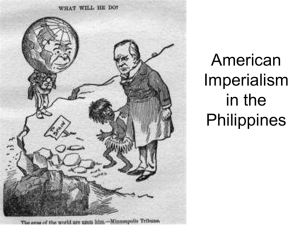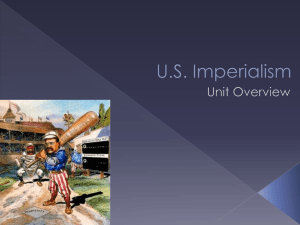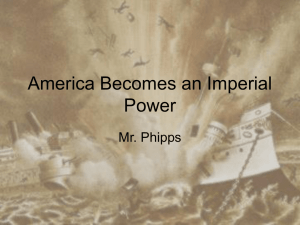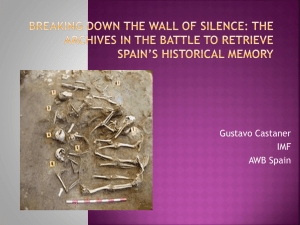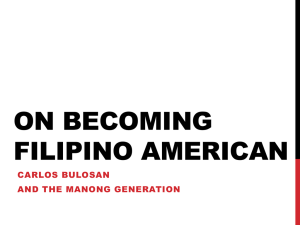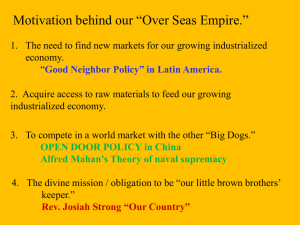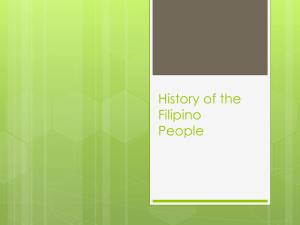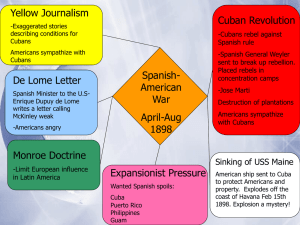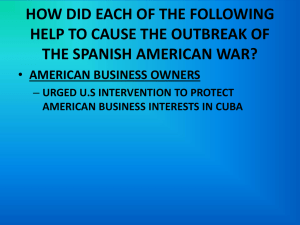File - PHIL. HISTORY
advertisement
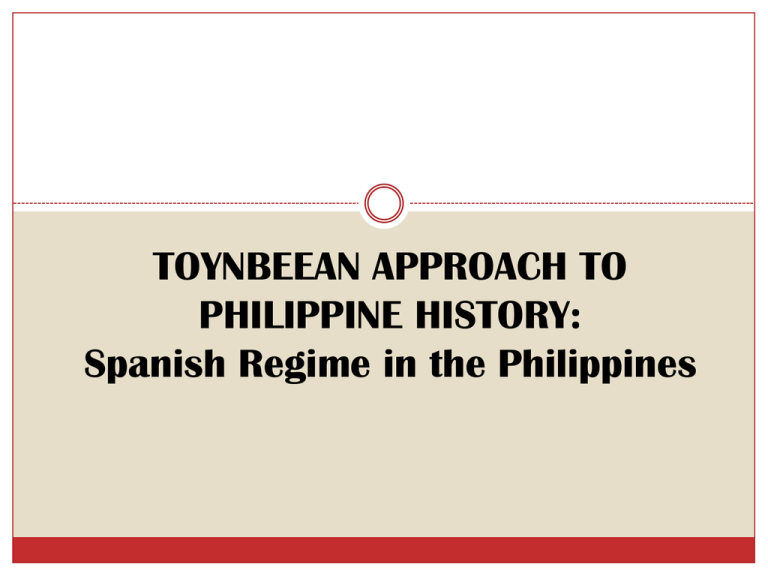
TOYNBEEAN APPROACH TO PHILIPPINE HISTORY: Spanish Regime in the Philippines Spanish Regime: 1571 - 1663 Successful Colonization - the enormous cost of the expedition - difficulties in the returning voyage Pacification - starting point of the expedition: Mexico instead of Spain - Hernan Cortes’ secret in pacification of Mexico: Treat the natives with respect Spanish Regime: 1571 - 1663 Reconciling Tribute with Justice How to derive revenue from the conquered without violating simple idea of justice? Encomienda System System was extension of pacification Grant was not property but of jurisdiction over a definite territory and its inhabitants The encomenderos had the duty of defending the encomienda; of maintaining peace and order and supporting missionaries These considerations entitled him with collected of tributes; within the means of the subject Spanish Regime: 1571 - 1663 Forming A Christian Civilization Convincing the natives to be Christians Dealing with Dispersed and scattered settlement Building Church - Centered Town Reduccion – barangays were coaxed and coerced into organized towns around the newly-built church with resident friar OBJECTIVE: Bring all indios into Christian communities ( Bajo de la Campana) The new settlement was helpful in collecting proper, complete and accurate tribute. Spanish Regime: 1571 - 1663 Transforming A Feudal Society into a Modern Nation How to develop the Philippines as a modern nation? How to unify the Philippines? Commercial Capitalism and Common Religion Commercialism was introduced Catholicism and Centralized Government Spanish Regime 1571 - 1663 o How to build infrastructure when there is shortage of Spanish manpower o How to stimulate agricul- tural production o POLO OR FORCED LABOR -ships, churches, roads, other forms of infrastructure -pay “falla” (exempted) o BANDALA -annual quotas to each Province for the sale of products Spanish Regime: 1571 - 1663 Effective Government How to govern the islands effectively? Centralized Authority The governorgeneral: executive, judiciary and legislative Visita,Residencia, Archbishop and subordinate public officials served as checks and balances King of Spain CENTRALIZED AUTHORITY Governor general The Governor General assumed the highest position in the land. Vested in him the powers of executor and legislator, and at times the judiciary. alcaldia Alcalde mayor corregidores ayuntamiento corregidor Governadorcillo pueblo Cabeza de barangay barrio Spanish Regime: 1664 - 1763 Dutch Aggression The Dutch Military attacked the Philippines Spanish Defense Used natives in attacking and defending the islands Spanish Regime: 1664 - 1763 Economic Rehabilitation after the Dutch War Finances were not stable; economy declined Local Production Export of products: wheat from Laguna and Batangas and mining products from Camarines Spanish Regime: 1664 - 1763 National Prosperity How to make the colony independent from Mexican aid? Galleon Trade Chinese goods were sent to Europe through the Manila – Acapulco trade Few men prospered in the galleon trade GALLEON TRADE • During the Spanish era Manila became the leading commercial center in the region • Also known as Manila-Acapulco Trade • Not all could participate in the Galleon trade • In the 19th century when commercial liberty was adopted as a European policy the Galeon trade decline • Lasted for 2 ½ centuries until its abolition Spanish Regime: 1664 - 1763 Chinese Economic Exclusion Laws and Domination Additional Taxation The Additional Chinese were dominating the economy Chinese were known as SANGLEYS which means merchants tax besides the annual residence tax immigration be limited Parian: nonChristian Chinese Spanish Regime: 1664 - 1763 Conflict Between the Regular and Secular Clergy The Spanish regular clergy were holding the parishes instead of Spanish seculars Development of a Native Secular Clergy Natives were permitted to enter priesthood Spanish Regime: 1664 - 1763 Moro Raids Muslims frequently attack islands in the Visayas; killing and pirating goods from the natives Moro Resistance Establishment of Pilar Fort in Zamboanga Juramentado in Jolo to resist the Spaniards in the place Spanish Regime: 1764 - 1897 Rehabilitation of a Shattered Economy Tobacco Monopoly The Philippines had been subsidized by Mexican treasury for decades Independence of Mexico The government implemented laws and policy in order for designated lands and places to cultivated the growth of tobacco. Forcibly asked the natives to work in the fields TOBACCO MONOPOLY • Governor General Jose Basco – founder • To improve the economy of the Philippines • Strict cultivation of tobacco was enforced in certain areas such as: Cagayan Valley, Nueva Ecija, Ilocos and Marinduque • Lasted from 1781 to 1881 Material and Social Advancement • Rise of Banks – Obras Pias – earliest banks in the Philippines which gave loan to merchants – Rodriguez Bank – the first Filipino bank established in Manila by Francisco Rodriguez – Banco Español- Filipino – first government bank in the Philippines founded by Antonio de Urbiztondo PHILLIPINE REVOLTS CAUSES : A) PERSONAL Led by datus, maharlikas and babaylan or catalonans Lost prestige and power in their communities Want to revert to their own culture (babaylans and catalonans wanted to return to native religions) Lakandula, Soliman, Tamblot, Bankaw and Dagohoy continuation B) RELIGIOUS MOTIVES/REASONS Led by those who built their own style of syncretic religions Non-acceptance of Spanish popes, bishops and priests Emergence of cults Hermano Pule, Francisco Rivera and Tapar continuation C) RESISTANCE TO SPANISH-IMPOSED INSTITUTIONS Taxation Forced labor Galleon trade Indulto de comercio Monopolies (like the tabacco and basi revolts) Magalat, Sumuroy, Palaris and Diego Silang continuation D)PEASANT UNREST Fraudelent land surveys which led to land grabbing Excessive cost of land rental fees Maginoos and principalias of Silang, Cavite Why Philippine Revolts failed A) INSULAR MAKE-UP OF THE PHILIPPINES -no sense of national unity because of communication gap; many ethn0-linguistic groups with their dialects but no lingua franca B) IDEA OF NATIONALISM CAME ONLY DURING THE 19TH CENTURY C) DIVIDE ET IMPERA -Spaniards used natives to fight other natives -co-optation and collaboration of some datus and maharlikas with the Spaniards continuation D) SUPERIOR MILITARY TECHNOLOGY AND STRATEGY OF THE SPANIARDS -Mexican horses -better firing projectile weapons (culverins, cannons, muskets, or guns) -network of spies E) INTERFERENCE OF FRIARS continuation F) ABSENCE OF GOOD LEADERS WHO KNEW MILITARY STRATEGY G) “PAPELETAS DE PERMISO” AND “CARTAS DE RADIO” -official travel permits and safe-conduct passes Spanish Regime: 1764 - 1897 Collapsed of Galleon Trade Source of income and livelihood Progress after economic stagnation Free Trade Opening of different ports in the Philippines through the suggestion of Sinibaldo de Mas Spanish Regime: 1764 - 1897 Spread of Liberal Ideas Carlos Maria de la Torre Liberalism from Europe Censorship Noli Me Tangere and other propaganda publication were banned by the government Spanish Regime: 1764 - 1897 Equality of the Regular and Secular Clergy Secularization of the parishes Execution of Gomburza Experience in Mexico Father Burgos believed in the secualrization FACTORS FOR THE RISE OF FILIPINO NATIONALISM A) SPREAD OF LIBERALISM -when Spain opened the Philippines to world trade, liberal ideas filtered in -liberal political filtered in from Europe (ideas of Montesquieu, Rousseau, Voltaire, Locke and Jefferson) -transformation of the Philippine economy into a raw material market for Europe increased their contact with the intellectual tradition of the west continuation B) Rise of the Clase Media (middle class) or Principales -middle class composed of Asian and Eurasian mestizos emerged from the economic boom derived from expanded agriculture and commerce -Spanish opening of the Philippine ports (1834) to free trade, commericialization of agriculture and economic expansion greatly benefited the “principalia” who were able to send their children to schools here and abroad, exposing them to more libertarian ideals. continuation C) Sentiments against the principales -masses were dissatisfied with the principales as intermediaries of the Spanish government D) Racial Prejudice -Spaniards regarded Filipino natives as belonging to an “inferior race”; called them “indios” -Spanish pre-conceived notion that natives could not rise beyond their “limited intelligence” continuation E) Cultural changes -Educational Reforms of 1863 dramatically improved the standards of education in the primary level -Filipinos were able to pursue higher education -young men from prosperous families were able to take up law, medicine and pharmacy -were able to see the repressive colonial policies of Spain -new breed of Filipinos, the “Ilustrados” continuation F) Secularization controversy -can be traced back from the year 1567 -in 1768, parishes were given to unprepared native seculars (Filipino priests who do not belong to a religious order) -by 1859, parishes were desecularized and were given back to regular priests (Spanish priests belonging to religious orders -Filipino priests opposed Spanish friar abuses and agitated for reforms continuation G) Cavite Mutiny of 1872 -Sgt. La Madrid led this mutiny due to the suspension of the privileges formerly enjoyed by arsenal workers and engineer corps of the Cavite Naval Shipyard -this mutiny was used by the Spaniards to implicate the liberal critics of the government including Filipino priests who fought for Secularization -the execution of GOM-BUR-ZA eventually hastened the growth of Filipino nationalism Spanish Regime: 1764 - 1897 Propaganda Movement Ilustrados (enlightened young men) called for reform in the government and assimilation of the Philippines to Spain Non-continuity and non- implementation of reforms Strict in implementing laws Intensified attack to the movement Friars wrote pamphlets against the propagandist Spain: 1880 -1890 Religious What was Spain like during the early 1880’s? How important was the environment to the young men of the Philippines who came to the Peninsula? Creoles and Mestizos Education Politics Filipinos in Spain • The young Filipinos were acquainted with a world different from the Philippines: freedom of speech against the church, church doctrine and the state; proclamation of liberties and progress. • The environment would become a STIMULUS for CALLING OF CHANGES in the / for the Philippines. • The grave defects of Spanish government in Spain led to the disillussionment of the Filipinos. • Rizal noted in his travels the progress of the places he visited; and recognized their native qualities superior to Spaniards; he believed that Filipinos can handle the affairs of the Philippines Early Activities of Filipinos in Spain Filipino nationalists prior to 1880: PEDRO PATERNO and GREGORIO SANCIANCO Sancianco gave a banquet for Fernando de Leon y Castillo, overseas minister of liberal government in Sagasta. Sancianco publish a book on the abolishment of the Tobacco Monopoly in the Philippines. Although helped the conomy of the Philippines, the abuses and negative consequences of the monopoly. Circulo-Hispano Filipino Tha banquet served as the foundation of CIRCULO-HISPANO FILIPINO Rizal wanted to give more substance to it; and to use it as vehicle to unite Filipinos. Revista del Circulo-Hispano Filipino
